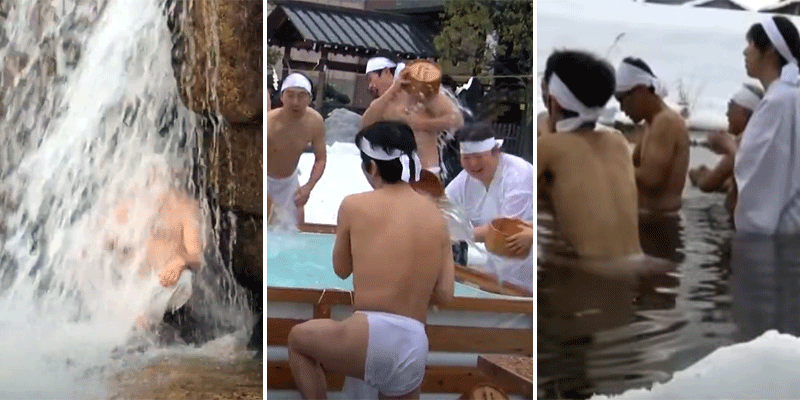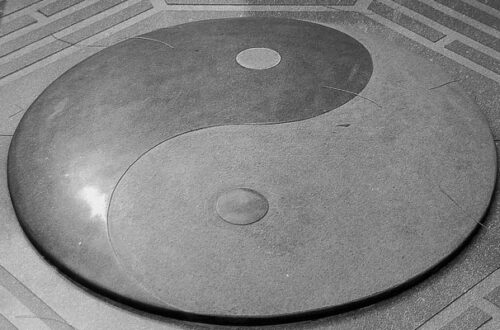
Purification of Body and Soul: Misogi in Japanese Culture and Aikido
Misogi 禊, deeply rooted in Japanese culture and religious tradition, is a ritual of purification aimed at cleansing both the body and the spirit. Typically, the ritual involves immersing oneself in water, often a natural body of water like a river or waterfall, to wash away impurities and negative energies. The attire is typically white garments, but in many cases, men may wear a loincloth. The practice dates back centuries, and it is said to originate from Izanagi 伊邪那岐, a kami in Japanese mythology, who felt contaminated and purified himself with water after his visit to Yomi 黄泉, the world of death, to see his deceased wife Izanami 伊邪那美.
Misogi rituals are commonly performed in religious ceremonies such as Shinto 神道 and Shugendo 修験道, as well as other celebrations. It represents a process of renewal and spiritual rebirth, where participants seek to rid themselves of past wrongdoings, negative thoughts, and attachments, thereby purifying their inner selves. In religious contexts, misogi is integral to worship and rituals at shrines, where participants cleanse themselves before approaching sacred spaces or participating in ceremonies.

Different forms of misogi
Misogi also holds special significance during Japanese New Year. While traditions vary, many individuals participate in misogi by engaging in ritualistic bathing in cold water on or near New Year’s Day, symbolizing the purification of the past year’s impurities and welcoming a fresh start. Depending on the region, children who have reached a certain age may undergo misogi as a rite of passage to be recognized as an adult for the first time.
Morihei Ueshiba had a deep connection to Shinto, which greatly influenced his martial art philosophy and spiritual beliefs. He integrated Shinto principles into the philosophy of Aikido, where misogi naturally became part of it. For Ueshiba, the significance of misogi transcended mere religious ritual. In Shinto cosmology, all things were born and animated following the interaction of Izanagi and Izanami. Everything was created through misogi, and Ueshiba believed this led to the discovery of Aikido. Therefore, the practice of misogi is essential in Aikido, as Aikido itself is misogi.
Ueshiba was a dedicated practitioner of misogi. In a notable event recounted in his biography, during a Shinji 神示 (divine revelation) on December 14, 1940, while he was engaged in misogi practice around 2 AM, Ama-no-Murakumo-Kuki-Samuhara-Ryu-O 天の村雲九鬼さむはら竜王 (the guardian deity of the Ueshiba family and Aikido) descended upon him. It enlightened him to the belief that the purpose of Aikido is not to kill or fight, but to love and fulfill the heavenly duty of purifying the world. This revelation became a central mission in his life.
Ueshiba elaborated on misogi on numerous occasions. Here are some excerpts from the book “The Secret Teachings of AIKIDO”:
- The purging of all evil impulses by means of the misogi that is based on heavenly truth is what I mean by the term Samuhara さむはら. It is the process of promoting world peace. It is what I call the true path of Bu 武.
- This is Aikido, the way established by the divine, the way that provides us with the means to truly perform misogi.
- The purpose of Aikido is to implement misogi. Misogi is aiki 合気, aiki began with misogi.
- In order to perform divine techniques, we need misogi of both body and spirit.
Ueshiba always emphasized the importance of misogi in Aikido practice. He believed budo training based on selfish thoughts and desires is a false path, which can lead to a disastrous result. One caught up with them will never progress spiritually. Therefore, one pursuing Aikido must cleanse his own heart and set aright his thoughts. When misogi is performed, the spiritual ascends and material descends. With enough misogi over time the spirit is invigorated and returns back to its original purity. Perhaps only then we can eliminate fighting and war from our world.
Suggested reading: Exploring the Significance of Torifune and Furitama in Aikido and Shinto Practice
Author’s Note: We appreciate your readership! This article serves as a preliminary introduction to the subject matter. While we aim for accuracy, we cannot guarantee the content’s precision and it may contain elements of speculation. We strongly advise you to pursue additional research if this topic piques your interest. Begin your AikidoDiscovery adventure! 🙂




